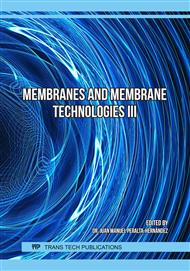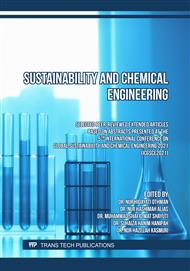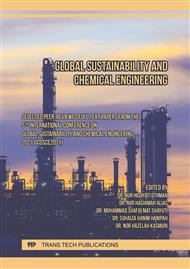[1]
K. Wangnick, IDA Worldwide Desalting Plants Inventory Report No.17, Wangnick Consulting GmbH, Gnarrenburg, Germany, (2002).
Google Scholar
[2]
A. Abbas, Simulation and analysis of an industrial water desalination, Chemical Engineering and Processing: Process Intensification, 44 (2005) 999-1004.
DOI: 10.1016/j.cep.2004.12.001
Google Scholar
[3]
D. Murad, Securing our water supply. The Star, 2021. Information on https://www.thestar.com.my/news/focus/2021/04/04/securing-our-water-supply.
Google Scholar
[4]
S.J. Doong, Advanced hydrogen (H2) gas separation membrane development for power plants, in: Advanced Power Plant Materials, Design and Technology, Woodhead Publishing. 2010, pp.111-142.
DOI: 10.1533/9781845699468.2.111
Google Scholar
[5]
M. Ahsan, O.M. Sweeney, A. Hussain, Development of user-defined extension for the simulation of membrane process in Aspen HYSYS, Sigma Journal of Engineering and Natural Sciences, 35 (2017) 35-45.
Google Scholar
[6]
I.G. Wenten, K. Khoiruddin, P.T.P. Aryanti, A.N. Hakim, Scale-up strategies for membrane-based desalination processes: A review, Journal of Membrane Science & Research, 2 (2016) 42-58.
Google Scholar
[7]
M. Sajjad, M.G. Rasul, Simulation and optimization of solar desalination plant using Aspen Plus simulation software. Procedia Engineering, 105 (2015) 739-750.
DOI: 10.1016/j.proeng.2015.05.065
Google Scholar
[8]
W. Cao, I.M. Mujtaba, Simulation of vacuum membrane distillation process for desalination with Aspen Plus. Industrial and Engineering Chemistry Research, 54 (2014) 672-680.
DOI: 10.1021/ie502874c
Google Scholar
[9]
N. Afrasiabi, M. Ehteshami, R. Ardakanian, Optimum design of RO membrane by using simulation techniques. Desalination and Water Treatment, 9 (2009), 189-194.
DOI: 10.5004/dwt.2009.770
Google Scholar
[10]
R. Ncube, F.L. Inambao, Membrane Modeling and Simulation for a Small Scale Reverse Osmosis Desalination Plant. International Journal of Engineering Research and Technology, 13 (2020) 4065-4083.
Google Scholar
[11]
N. Aghababaei, Reverse osmosis design with IMS design software to produce drinking water in Bandar Abbas, Iran. Journal of Applied Research in Water and Wastewater, 4 (2017) 314-318.
Google Scholar
[12]
Hydranautics, (2021). Element Specification Sheet. A Nitto Group Company. Information on https://membranes.com/knowledgecenter/element-specification-sheets/.
Google Scholar
[13]
J.S. Kim, J. Chen, H.E. Garcia, Modeling, control, and dynaic perfomance analysis of a reverse osomosis desalination plant integrated within hybrid energy systems, Energy, 112 (2016) 52-66.
DOI: 10.1016/j.energy.2016.05.050
Google Scholar
[14]
M Maddah, H.A. Almugahwi, Application of the solution-diffusion model to optimize water flux in reverse osmosis desalination plants. In AWWA/AMTA Membrane Technology Conference and Exposition (2017).
Google Scholar
[15]
V.V Gedam, J.L. Patil, S. Kagne, R.S. Sirsam, P. Labhasetwar, performance evaluation of polyamide reverse osmosis membrane for removal of contaminants in ground water collected from Chandrapur district, J. Memb. Sci. Technol., 2(2012) 2-5.
DOI: 10.4172/2155-9589.1000117
Google Scholar
[16]
I.S. Al-Mutaz and M. A. Al-Ghunaimi, Performance of reverse osmosis units at high temperatures. In in The Ida World Congress On Desalination And Water Reuse, Bahrain, (2001).
Google Scholar
[17]
N.A.M. Ameen, S.S. Ibrahim, Q.F. Alsalhy, A. Figoli, Highly saline water desalination using direct contact membrane distillation (DCMD): Experimental and simulation study, Water, 12 (2020) 1-24.
DOI: 10.3390/w12061575
Google Scholar
[18]
Applied Membranes Inc., (2007). Factors affecting ro membrane performance. Information on https: //www.watertreatmentguide.com/factors_affecting_membrane_ performance.htm #Figure_2.
Google Scholar





